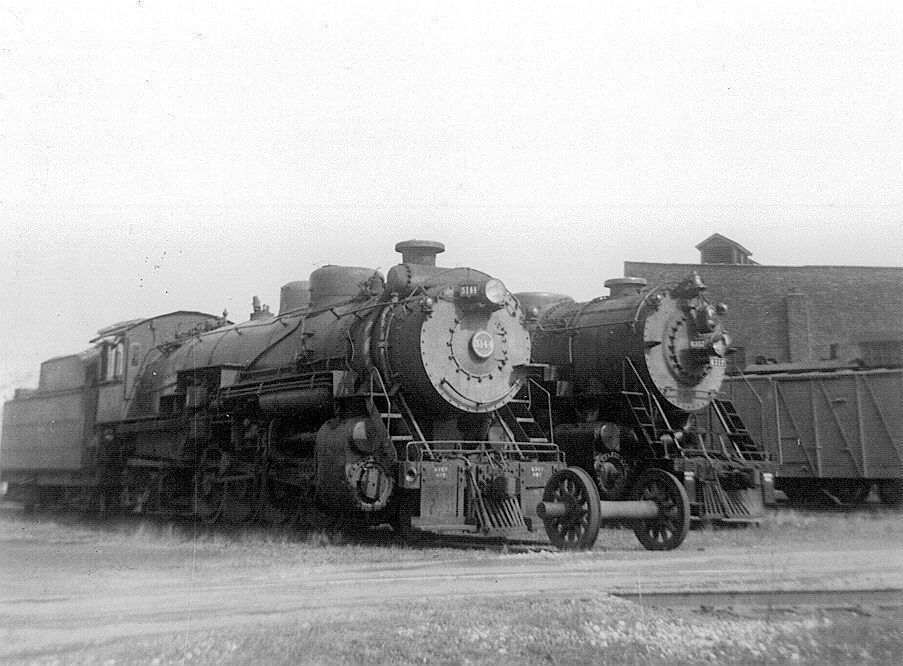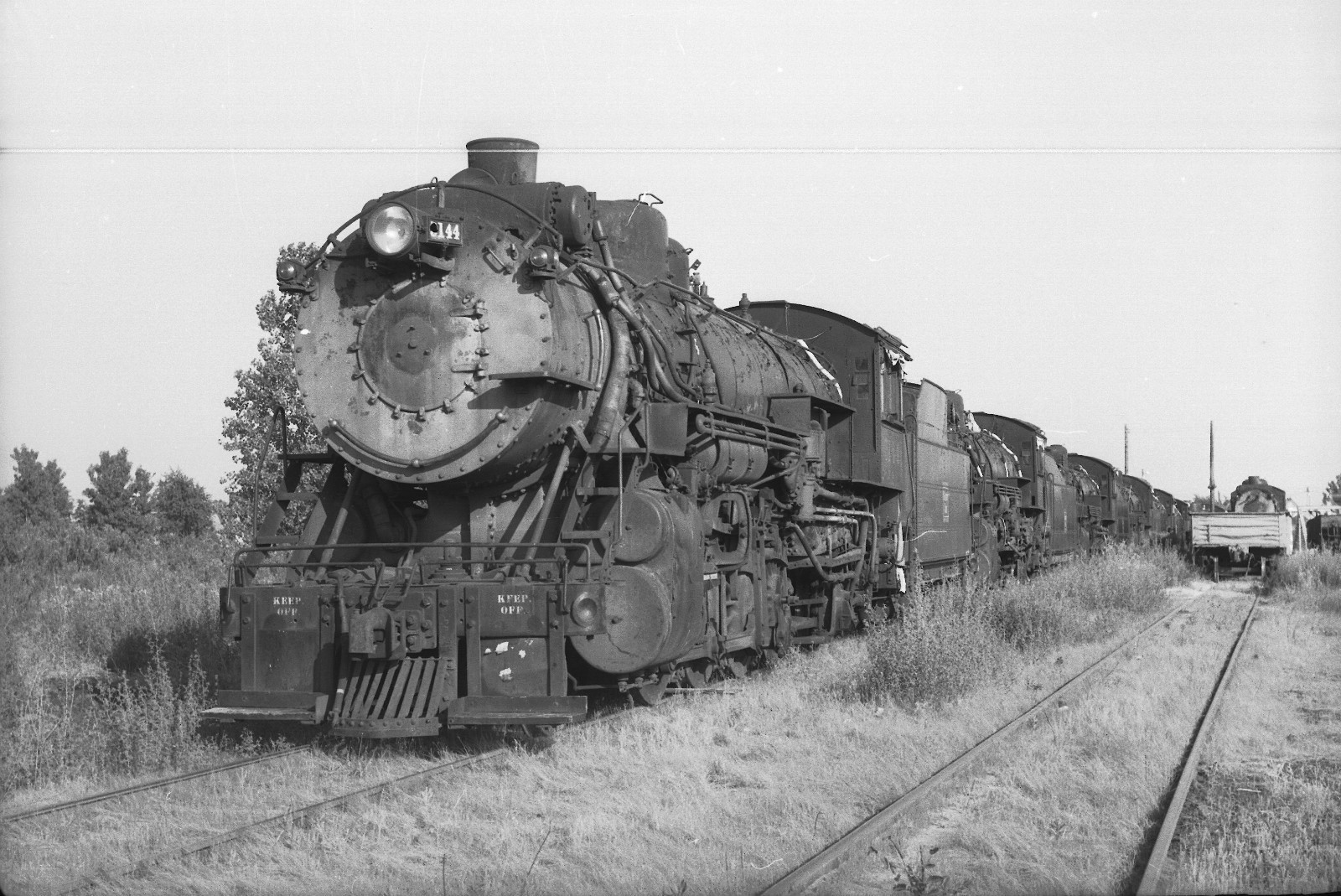Another L&B equipped engine, that spent the last ten years or so, on the Beardstown Division, was 4976, which was one of the last five active steam engines at Herrin Junction.
From: "LZadnichek@aol.com [CBQ]" <CBQ@yahoogroups.com>
To: CBQ@yahoogroups.com
Sent: Wednesday, February 4, 2015 1:30 PM
Subject: Re: [CBQ] What's Wrong With 5030? [2 Attachments]
February 4, 2015
Hol, Jonathan, Charlie and other Group members who participated in
this discussion - Well, again, Hol has nailed it. What was "wrong," or perhaps
"unusual" with 5030 to me, was its conventional smoke box with the lignite
marker on the tender's coal bunker. I personally wasn't aware that by changing
grates an O-1 could be converted to burning lignite (okay, sub-bituminous
coal). I had thought it also required an L&B front end.
My Dad had some limited experience with lignite burners during his
time as a transportation inspector and train master on Lines West in the early
1950s. Dad said they steamed best with a very light fire on the grates
and that the engineer had to be careful in adjusting the Johnson bar. If
the engineer worked the locomotive too hard, the forced exhaust would
literally lift the burning coal up off the grates, through the flues and out the
stack in a fiery display. For that reason, I'm particularly surprised that the
5030 was being used as a switcher in the Denver yards without a L&B
front end with all its internal baffling/netting to prevent hot ashes and
cinders from blowing out of the stack. You'd think the danger from fire
in the yards and adjacent industrialized areas would've precluded a lignite
burner without a L&B front end. In later years, locomotives fitted with a
L&B front end wandered across the system and even into southern Illinois,
about as far from the Colorado sub-bituminous coal mines as you could get.
I'm inserting/attaching two views of L&B equipped Class O-1-A 5144 taken at
Centralia, IL, where the locomotive finished-up its service life:
 Pulled from their cozy stalls, 5144 and a Class M-4-A sit in the cold
outside the Centralia, IL, roundhouse in March 1958 awaiting a call
back to service that probably never came. Since both locomotives' stacks are
covered with cylinder head covers, that would indicate they were at the time
stored serviceable.
A little over two years later in the early summer of 1961, 5144 has been
assembled with other remaining steam power at Centralia into a funeral train for
movement north to Galesburg, IL. The Corbin book records that 5144 was
sold for scrap in June 1961, no doubt to Northwestern Steel & Wire
at Sterling, IL.
Hol, thanks for answering all my questions and enlightening our Group on
lignite burners and their L&B front ends. Perhaps, this, too, would make for
a good subject in a future BRHS publication. Yes, yes, please continue sharing
your images and knowledge. I'd be particularly interested in FW&D
locomotives of which, at least for me, has been a dark hole for steam images and
stories. Best Regards - Louis
In a message dated 2/4/2015 12:16:17 P.M. Central Standard Time,
CBQ@yahoogroups.com writes:
Jonathan: Looking at later assignment sheets (I'm
going through tabulating all the C&S power leased to the Q through the
years), the 5030 was transferred to the Omaha Division by August 1940 and
to the Lincoln Division by July 1941 and in neither of these assignments is it
shown as a lignite burner, meaning all it probably had when assigned to Denver
were lignite grates and those were removed and bituminous grates substituted
when it moved east from Denver. Hol
To: CBQ@yahoogroups.com From: CBQ@yahoogroups.com Date: Wed, 4 Feb 2015
09:40:47 -0800 Subject: RE: [CBQ] What's Wrong With 5030?
Thanks for the very clarifying explanation, Hol,
especially regarding the internal smokebox modifications that allowed lignite
to be used as fuel without the extension. I stand corrected. I didn't have
access to the 1938 list of assignments, only the 1935 list in Corbin and
Kerka, Steam Locomotives of the Burlington Route (p. 292). In that
list, nine O-1's are assigned to Denver, six of which are indicated to be
lignite burners, though none of these is shown to have the L&B front end.
The three exceptions (not lignite burners) are 5030, 5057, and 5059. So I
assumed (as Ken Middleton said) that 5030 had the "wrong" tender. The
modification must have been made at some point between 1935-38. Louis's photo
shows a remarkably clean looking engine, especially for a switcher; perhaps it
had just been shopped and modified to burn lignite. Interesting, too, that it
has marker lights as well as a switcher pilot.
I realized that I'd never actually see n lignite, so I googled some
pictures, and the range of colors is striking, pointing to what you said about
the Burlington's engine fuel being sub-bituminous and not true lignite. Some
images labeled "lignite" showed coal that was black and shiny,
indistinguishable to my eye from bituminous coal, some was black but not
shiny, and some was the color of roasted coffee.
Again, thanks for taking the time to explain this stuff. The photos you
share, as always, are superb.
Jonathan
---In CBQ@yahoogroups.com,
<holpennywagner@...> wrote :
As far as I can see, there's absolutely nothing wrong with the
5030. No, it does not have an L&B front end, but that does not mean
it's not a lignite burner, which in fact it is, as identified by the yellow
square at the rear of the tender coal bunker. B y the 1930s the 2-foot
smokebox extension with its additional baffles and netting (wire mesh) for
lignite burning had still not been applied to every locomotive on the
lignite burning divisions of Lines West. So with only the addition
of a set of lignite grates (which were basically flat castings with numerous
small holes in them rather than the much more open grates for burning
bituminous), some locomotives became lignite burners. Bear in mind
that what was commonly called lignite in referring to the coal
burned on the western end of the Q was not really lignite but actually
sub-bituminous coal. True lignite is brown and looks more like decaying
wood than coal. It's a truly unsatisfactory locomotive fuel. The
sub-bituminous coal produced in the northern Colorado, Sheridan and Powder
River Basin coal fields has a lower BTU than bituminous and is low in moisture
and sulfur content but produces large amounts of ash. In the Q era the
only Power River Basin coal being mined was in the vicinity of Newcastle, Wyo.
(where the Cambria Branch long served the mines north of Newcastle) and just
east of Gillette. Today, Powder River Basin coal fuels a major portion
of the nation's power generating capability, and hauling it has made BN/BNSF,
and to a lesser extent UP, a great deal of money. Back to the
5030: The Q's August 1, 1938, assignment sheet shows eight O-1 Mikes
assigned to switching service at Denver: 5010, 5023, 5027, 5030, 5036,
5039, 5057 and 5059. All are shown as being lignite coal burners, but
only 5057 is shown as having an L&B front end. The symbol for
lignite burner was a square (as in the yellow one on the tender coal
compartment), while the symbol for L&B front end was a square with an X
inside. And the L&B front end O-1 assigned to Denver -- the 5057 --
was the only one of the eight not equipped with a superheater.&n bsp;
Incidentally, until spring 1935 the term L&B front end was not used;
instead the square with an X inside indicated "spark eliminator." The
last use of the lignite coal burner designation was on the Feb. 1, 1951,
assignment sheet; the March 1, 1951, sheet shows only the L&B front end
designator. By Oct. 1, 1941, the Q's Denver O-1s were the 5010,
5023, 5039, 5055, 5057 and 5059, and only the 5039 was listed as a
lignite burner, the other five shown with L&B front ends. By
Jan. 1, 1942, all six were shown with L&B front ends, so the extended
smokeboxes were still being applied. The real oddity among
the Denver O-1s, however, was the 5039, plus two sisters, the 5004 and
5010, which were leased to the C&S from July 1945 until at least October
1946 and used in Denver yard switching by the subsidiary. And since
locomotives assigned to C&S Denver switching duties fell under the
purview of the Joint Operating Agreement with the Santa Fe (better known as
the Joint Line agreement), the 5039's tender lost its Burlington Route
herald and received the initials of the C&S and AT&SF. We're not
sure it the other two got the same treatment, but happily Dick Kindig
photographed the 5039 on Oct. 13, 1946, , and a copy of that image is
attached, along with one showing the 5010 on the Q in Denver at an earlier
date, without an L&B front end. Anybody want me to
delver further into the use of Q steam locomotives by the C&S and
FW&D and the use of C&S steam power on the Q? If so, I'll start
scanning some images of C&S power in use on the
Q. Hol
To: CBQ@yahoogroups.com From: CBQ@yahoogroups.com Date: Tue, 3 Feb 2015
17:14:57 -0800 Subject: RE: [CBQ] What's Wrong With
5030?
[Unable to display image]
5030 wasn't a lignite burner. Note
that it doesn't have the L&B front end. Let's hope there was bituminous
coal in that tender, yellow square notwithstanding.
Jonathan
__._,_.___
Posted by: "John D. Mitchell, Jr." <cbqrr47@yahoo.com>
![]()
__,_._,___
|

